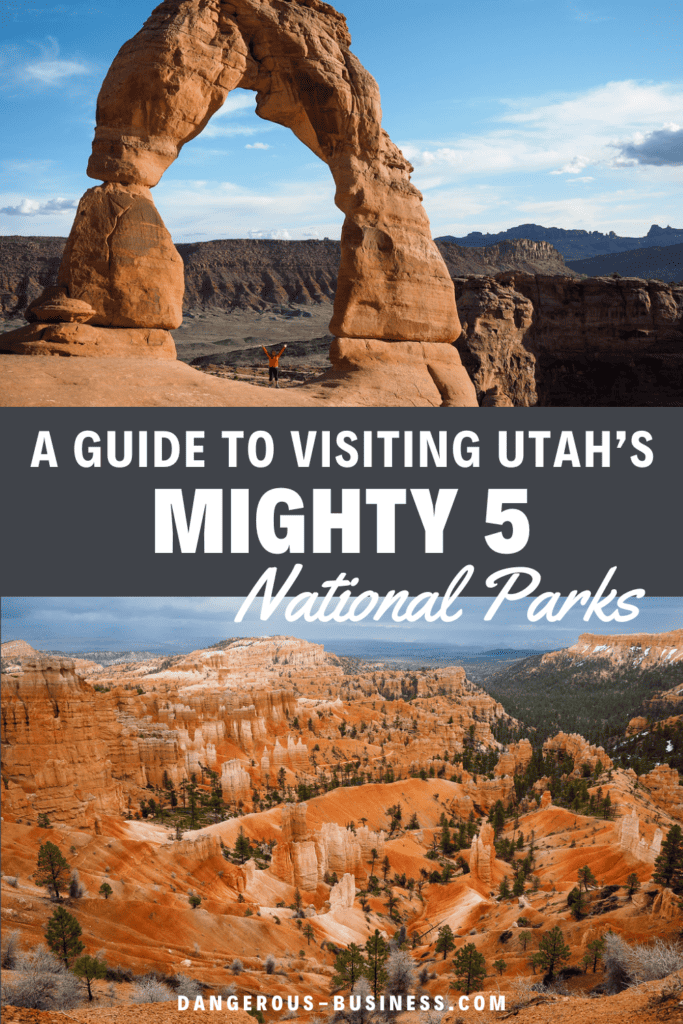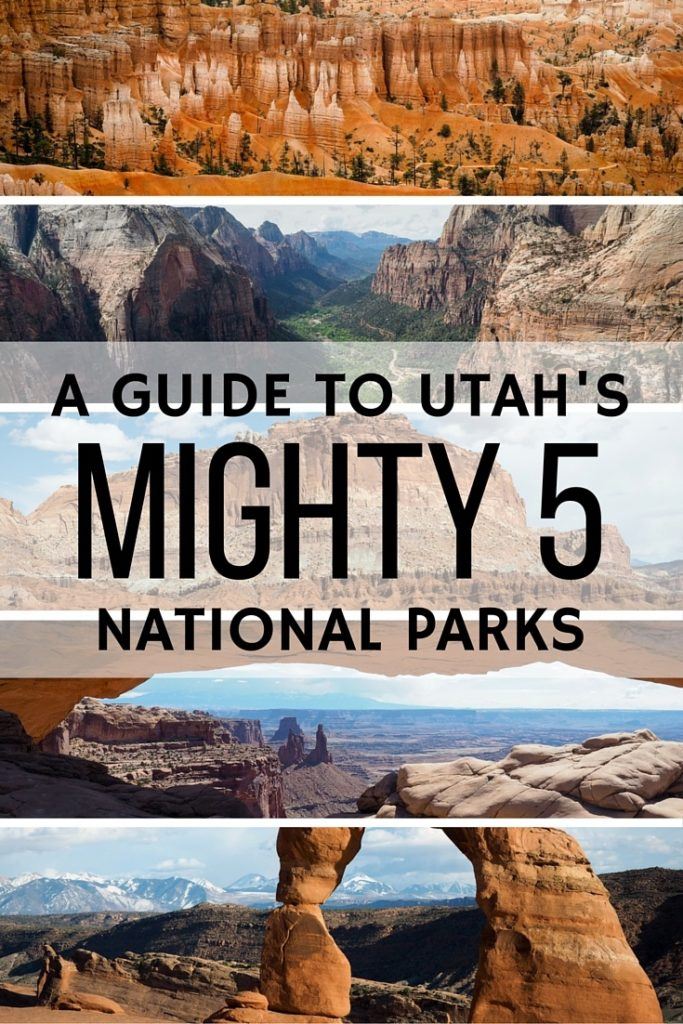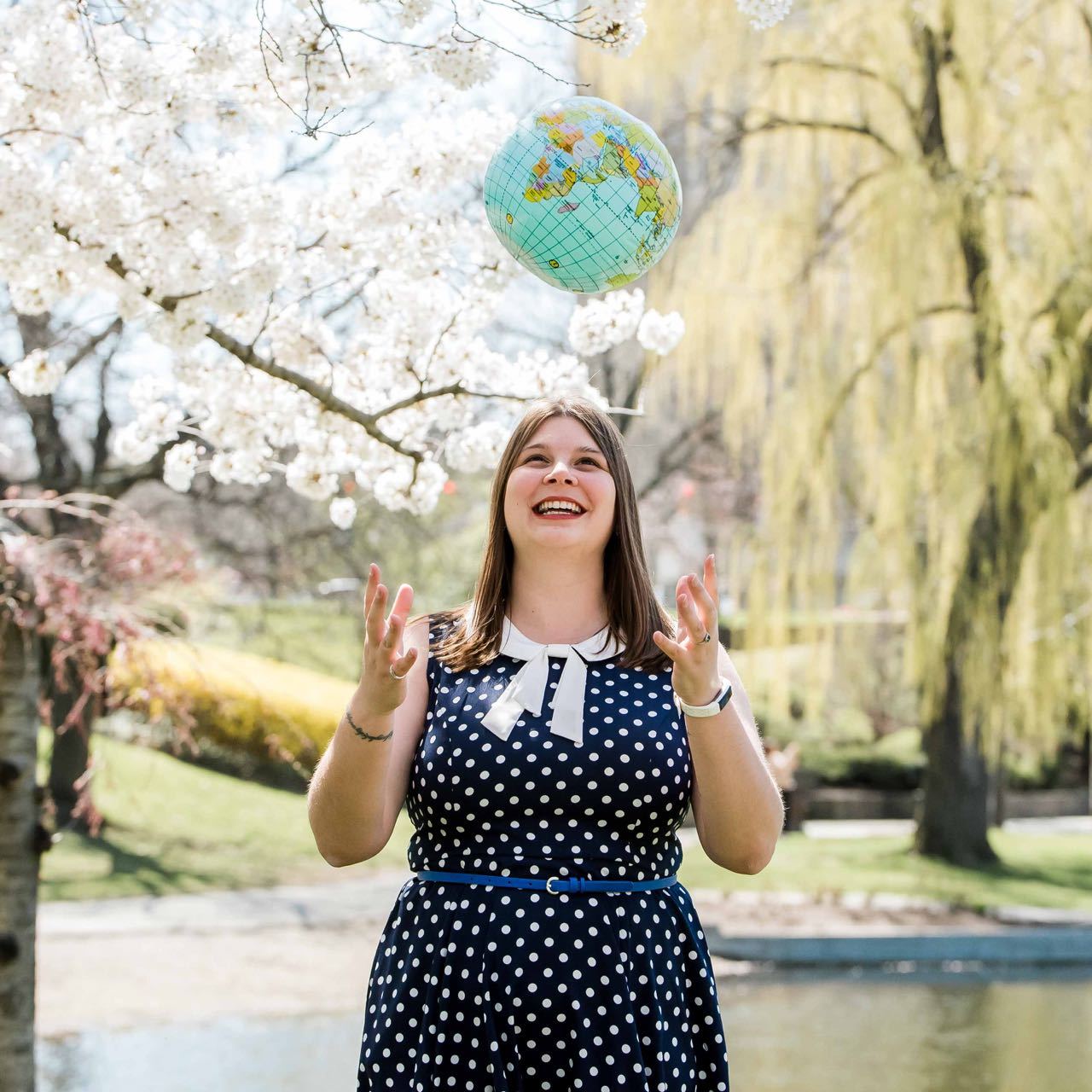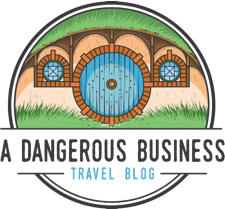When it comes to national parks, the United States has its fair share of iconic ones. From the Grand Canyon to Yellowstone to Yosemite, the National Parks Service recognizes some of America's most epic landscapes and ecosystems with its 63 national parks – and that's not even counting the 350+ additional memorials, monuments, historic parks, and more that the NPS manages.
But I have to confess that I think Utah's national parks are the very best.
Utah has not one, not two, but FIVE incredible national parks. These parks are so good that they've earned the nickname “the Mighty 5” – and this post will help you learn all about them and why they're all worth visiting!

What are the Mighty 5 national parks?
Utah has a little bit of everything when it comes to landscapes, from snowy mountains to arid deserts. And it's mostly in the state's southern desert region that you'll find the Mighty 5 national parks.
The five national parks that make up the Mighty 5 in Utah are:
- Zion National Park
- Bryce Canyon National Park
- Capitol Reef National Park
- Canyonlands National Park
- Arches National Park
And, having visited all five of the “mighty” national parks in Utah, I have to say that the name is well-suited.

If you're plotting out your American Southwest bucket list, you won't want to skip southern Utah. And, to make it easier to decide which of the Mighty 5 parks you'll want to visit, here's what you need to know about visiting each one.
Mighty 5 travel guide to Utah national parks
NOTE: If you plan to visit all of the Mighty 5 parks in one trip, you absolutely will want to get yourself a National Parks Pass. They cost $80 and are good for one year (you can buy them online, or at the first National Park site you visit). You'll save lots of money on this trip if you have one!
1. Zion National Park
If you're headed into southern Utah from Las Vegas (which is the route I suggest in my Southwest road trip itinerary), Zion National Park will be the first park you'll encounter. It became a national park in 1919, and many people cite it as their favorite national park in America. (It's certainly one of my favorites, too!)

Entry: $35 per private vehicle; $20 per person if you walk or ride a bike/shuttle in
Getting around: You can drive the Mount Carmel Highway east from Zion to where it joins with US 89 any time of year (and I do definitely recommend this drive – it's gorgeous!), but for seeing the rest of Zion Canyon, you have to use Zion's free shuttle service to get around from March through October. You can park at the visitor's center or in the nearby town of Springdale and use the shuttle to get to various trailheads and lookouts. (More shuttle info here.)
You can also reach the lesser-visited Kolob Canyons section of Zion from I-15 – it's about a 45-minute drive from the main Zion Canyon.


What it's known for: Zion is known for its towering mountains and red canyons, which were carved out by the Virgin River. It's also known for popular (if difficult) hikes like Angels Landing and The Narrows.


If you have one day: With just one day, I would suggest tackling some of Zion's shorter hikes. Perhaps Angels Landing* in the morning, and then an easy hike to the Emerald Pools in the afternoon.
Or, if Angels Landing is a bit too strenuous for you, take a hike along the Virgin River, go to Canyon Overlook, or walk the paved Pa'rus Trail. You could also rent a bike for half a day if you'd prefer to cycle rather than hike.
*Note that permits are now required to hike Angels Landing. You can apply for a hiking permit during four different seasonal lotteries, or in a day-before lottery. Permits cost $6, and often sell out. You will NOT be able to hike beyond Scout Lookout without a permit. Find more info on how to get an Angels Landing hiking permit here.

RELATED: I Hiked to Angels Landing and Didn't Die!

If you have more than one day: The Narrows – the famous hike that has you exploring Zion's narrow slot canyons – takes a full day, so I would only suggest it if you are in Zion for more than one day. It's a tough trail that requires you to wade through the river, so it's usually only open during the summer months when there's no threat of rain. If there's *any* chance of flash flooding, you don't want to attempt this hike.
OR you could spend your second day exploring the Kolob Canyon section of Zion. (There's plenty to do in Zion, even if you don't like hiking.)

Top tour option: Explore Zion on a half-day hiking and biking tour with a local guide.
There are cool things to do around Zion, too. If the park itself is a bit crowded, you could also try a slot canyon tour, or even go horseback riding.
Where to stay: The town of Springdale is less than 5 minutes away from the main entrance to Zion. The town is adorable, and has plenty of hotels and restaurants to pick from. I stayed at the La Quinta Inn Zion Park/Springdale, which is a newer property with big rooms and mountain views. (Read reviews on TripAdvisor | Book here)
Another good hotel option is Springhill Suites by Marriott, or you could book a cute cottage at Red Rock Inn Cottages.
If a vacation rental is more your speed, you could try this townhouse in Springdale (great for families).

RELATED: Things to Do in Zion National Park That Don't Involve Hiking
2. Bryce Canyon National Park
The next park along the Utah national parks trail is Bryce Canyon, which can be reached via US 89 from Zion. Even though it also is filled with sandstone like Zion, the rock formations here are entirely different.

Entry: $35 per private vehicle
Getting around: During the summer months, a free shuttle takes visitors to all of Bryce's popular viewpoints, but it's not mandatory here like in Zion. You can self-drive through Bryce, too, and stop off at all the viewpoints – just beware of possible snow/ice during fall, winter, and spring, since Bryce is at a higher elevation.

What it's known for: Bryce Canyon is known for its eroded sandstone towers known as hoodoos – the National Park Service says Bryce has the largest collection of hoodoos anywhere in the world! Stopping at all the viewpoints, therefore, is the most popular thing to do at Bryce Canyon (Sunset Point and Inspiration Point are my favorites).

If you have one day: If you only have one day at Bryce, be sure to make it to all the overlooks and viewpoints. Start all the way out at Rainbow Point, and then make your way back in: Inspiration Point, Natural Bridge, Sunset Point, etc. There's an easy rim walk between Sunset Point and Sunrise Point that's worth doing, too.



If you have more than one day: Get down inside the canyon if you have the time. The best hike to get up-close with the hoodoos is the Navajo Loop, which you can join up with either Wall Street (in the summer) or the Queen's Garden trail (usually open year-round) for a complete hike. Or, if you want something longer and more strenuous, check out the Peek-A-Boo Loop.
RELATED: A Foggy, Soggy Day of Hiking at Bryce Canyon


Top tour option: Want to see Bryce Canyon on a guided tour? This 3-hour Bryce tour with a local guide is a great option. It includes both sightseeing and hiking.
Where to stay: Bryce Canyon is kind of in the middle of nowhere, but there are a couple of hotels within a few miles of the park's entrance. I stayed at the Best Western PLUS Bryce Canyon Grand Hotel, which is large and newer and had a good free breakfast buffet (Read reviews on TripAdvisor | Book here). Nearby Ruby's Inn is also popular (and is basically the only place to have dinner near the park in the off-season).
3. Capitol Reef National Park
As far as national parks go, poor Capitol Reef is the park that gets overlooked the most often in Utah. If you head east from Bryce on UT-12 and UT-24, you'll drive through a portion of Capitol Reef starting in the town of Torrey – but many people don't stop.
If Capitol Reef was in any other state, it probably would be really popular! But, in Utah, it's usually the park people spend the least amount of time in. (And I'm guilty of it, too!)

Entry: $20 per private vehicle
Getting around: Driving yourself is the only way to get around Capitol Reef. You'll see some of the park's famous rock formations (for free) if you're driving along UT-24, but to really see the park, you need to tackle the scenic drive within Capitol Reef's fee area.

What it's known for: Located in the heart of Utah's red rock country, Capitol Reef is known for its cliffs and canyons in the Waterpocket Fold, which is essentially a wrinkle in the earth's crust.
If you have one day: One day is enough to see the highlights of Capitol Reef, which include all the stops along the scenic drive. You'll see cliffs, canyons, ancient petroglyphs, rippled rock, and more.

If you have more than one day: There's some hiking to be done in Capitol Reef, including 15 day-hikes that range from short and easy to more strenuous. You can check out the hikes here. (Full disclosure: I didn't do any hiking here, so I can't recommend any specific trails.)
Top tour option: Try this off-road adventure in Capitol Reef, which will have you exploring 70 miles of this lesser-visited national park.
Where to stay: The small town of Fruita is at the center of Capitol Reef National Park, but the town of Torrey has more options when it comes to hotels. Check out the Capitol Reef Resort, which would be my top pick in the area. (Read reviews on TripAdvisor | Book here)
4. Canyonlands National Park
Next up is Canyonlands National Park, in southeastern Utah near the town of Moab. Canyonlands is actually broken into three different sections: Island in the Sky, The Needles, and The Maze, and has two major visitor centers (one at Island in the Sky, and one at The Needles).

Entry: $30 per private vehicle
Getting around: Self-driving is the best way to explore Canyonlands, especially if you want to visit more than one section of the park. (There's roughly 60 miles of road between the Island in the Sky and Needles entrances, for example.)

What it's known for: True to its name, Canyonlands is famous for its canyons and buttes that have been carved out by the Colorado River (the same river that carved out the Grand Canyon). It's also known for its excellent mountain biking, with the 100-mile White Rim Road at Island in the Sky being the most popular trail.

If you have one day: The Island in the Sky district is the easiest to access – it's less than an hour from Moab, and paved roads make it easy to reach all the viewpoints and trailheads. With one day, I would recommend visiting the famous Mesa Arch in the morning (it's really popular at sunrise), going to the viewpoints at Grand View Point and the Green River Overlook, and then doing a short hike out to Upheaval Dome.


If you have more than one day: With an extra day, definitely drive out to The Needles, which is the second-most-accessible district in Canyonlands. The Needles is made more for hikers, with an extensive system of more than 60 miles of interconnecting trails.
Top tour option: Explore Island in the Sky on this 4×4 tour of Canyonlands from Moab.
Where to stay: Canyonlands is most easily accessed from Moab. I stayed in a cute apartment rental in Moab (like this one), but there are also plenty of hotels and motels in town (along with lots of restaurants) to choose from. Check out the La Quinta Inn and Suites Moab, or the Holiday Inn Express Moab.
Other cool vacation rentals in the area include this Adobe home with a hot tub and incredible views, and this 3-bedroom house that's right in the center of Moab.
5. Arches National Park
The last of the Mighty 5 national parks is Arches, also close to Moab in southeastern Utah. This park is very different from the other four on this list, and I also think is one of the most accessible since it's only about 15 minutes from Moab and is filled with short, easy walks to see the famous arches.

Entry*: $30 per private vehicle
*Note that Arches National Park now requires timed park entry by reservation in order to help alleviate congestion in the park between 7 a.m. and 4 p.m. You'll need to reserve a timed entry slot from April 1-October 31. Reservations cost $2 and are being released in 30-day increments 3 months in advance. Learn more and reserve your entry time here.
Getting around: There are no shuttles at Arches, so you'll need your own vehicle to explore the 18-mile-long scenic road through the park.
What it's known for: The sandstone arches, of course! The park has more than 2,000 natural stone arches, along with pinnacles, cliffs, and balanced rocks. The rocks are also a brilliant orange-red, which looks great in photos.


If you have one day: In the morning, explore the scenic road and stop off at some of the viewpoints/shorter walks – Park Avenue, Balanced Rock, the Windows Section, and Double Arch would be my top picks. In the evening, hit the trail out to Delicate Arch, the most famous arch in the park and the symbol of the state of Utah. The hike is tough going up, so allow yourself 1-1.5 hours to reach the arch in time for sunset. At sunset, the sun paints Delicate Arch an incredible rusty orange color.
RELATED: Iconic Utah: A Sunset at Delicate Arch



If you have more than one day: You can see all the major highlights of Arches in just one day, but if you have a second day, consider the Devils Garden Trail hike (7.2 miles total), or perhaps a ranger-guided hike of Fiery Furnace.
Top tour option: Don't want to drive yourself? Book a half-day tour of Arches in a 4×4 and see all the highlights.
Where to stay: Arches is most easily accessed from Moab. I stayed in a cute apartment rental in Moab (like this one), but there are also plenty of hotels and motels in town (along with lots of restaurants) to choose from. Check out the La Quinta Inn and Suites Moab, or the Holiday Inn Express Moab.

Utah national park road trip
Want to visit Utah's Mighty 5 national parks all in one trip? You definitely can! You need about a week to fully explore them all (or longer if you can manage it!)
My ideal Utah national park trip would look like this:
- Fly into Las Vegas
- 2 nights near Zion National Park
- 1 night Bryce Canyon National Park
- 1 night Capitol Reef National Park
- 2-3 nights in Moab (for Canyonlands and Arches)
- Fly out of Salt Lake City
Or you can check out my 10-day Southwest road trip itinerary for more ideas!
When to visit the Mighty 5 parks
Utah's Mighty 5 national parks are open year-round, so technically you can plan a trip at any time!
Most of Utah's parks remain mild in the winter and get downright HOT during the summer months – with the exception of Bryce Canyon, which is at higher elevation and does experience snow and cold temps during the winter months.
The best months to visit Utah's national parks are April-May and September-October, when temperatures are more mild and there are fewer crowds. I would personally avoid most of these parks in July and August, when they are the busiest and hottest.

Know before you go
Before you head out to the Mighty 5 national parks in Utah, here are a few more tips for you:
- Bring water. You'll always find water bottle filling stations at the visitor centers of each park, but you usually won't find any along the hiking trails or even along the scenic drives. Zion and Bryce are at higher elevation, but still get warm in the summer. And Canyonlands and Arches get downright HOT, with daytime summer temperatures frequently reaching 100 degrees (F). MAKE SURE you have enough water with you, especially if you plan to do any longer hikes. I recommend getting a daypack with at a built-in reservoir rather than carrying just one water bottle.
- Wear good shoes. If you're just doing scenic drives, your flip flops will be fine. But if you decide to tackle any of the longer hikes, you NEED proper footwear. And I don't just mean your favorite pair of hot pink Skechers – you need hiking boots. I saw people with Converse and Skechers on the Angel's Landing trail, and they were slipping and sliding all over the slickrock (sandstone). I love my Merrell Moab hiking boots (they're even NAMED after a spot in Utah!) – I wore them for every hike on this trip.
- Be prepared for every kind of weather. Many of Utah's national parks have their own little micro-climates – meaning you can never fully predict what the weather will be like. Wear layers that you can shed (or put back on), and always pack a raincoat in your daypack. (I love the Columbia Arcadia II jacket, as it's very waterproof.)
- Beware the sun. Getting sunburnt is the worst – avoid it by applying (and re-applying) sunscreen, and wearing a hat when possible.
- Get a National Parks Pass. If you do the math, visiting the Mighty 5 all in one trip will set you back more than $150. This is where an annual pass for the national parks comes in handy. The “America the Beautiful” pass costs $80 and is good for 12 months – meaning it will save you quite a bit of money if you plan to visit a bunch of national parks.
Which of the Mighty 5 national parks would YOU most like to visit?
Pin it for later:



Amanda Williams is the award-winning blogger behind A Dangerous Business Travel Blog. She has traveled to more than 60 countries on 6 continents from her home base in Ohio, specializing in experiential and thoughtful travel through the US, Europe, and rest of the world. Amanda only shares tips based on her personal experiences and places she's actually traveled!










What airport would you recommend flying into? Planning to visit all 5 if possible. Thinking of Flying into Las Vegas or Salt Lake City.
We flew into Vegas, since we did a loop that also included northern Arizona. It’s also usually easier to find cheap flights to Vegas rather than Salt Lake.
Nice pictures! Utah has been inching up on my places to explore list and I can see why even more so! Super informative post you’ve got.
I’m pretty sure it’s the most beautiful state I’ve visited! Definitely worth exploring.
Nice post. And some really beautiful photos!
Thanks, Stephen!
Thank you for this post! I hoping to visit these parks in the next couple years. This post is extremely helpful. Utah seems like such a unique & beautiful place!
You’re very welcome, Kaili! Hopefully this gives you a better idea of which parks you’ll want to visit on your own trip!
You’re right. Utah really delivers when it comes to National Parks. So many amazing ones to check out. I’d love to do a similar trip. What time of year do you think is the best time to go? It looks beautiful in your photos with a bit of snow around.
We went in April, which I liked – less crowds, and cooler weather. Though not all the trails were open yet, and the shuttles at Bryce don’t start up until May. (Also, if you want to tack on a visit to the Grand Canyon, the North Rim also doesn’t open until mid-May.) I think early fall (like late September) would also be a great time to go, though I haven’t personally visited during that time.
I love Utah – been to all of these parks except Capitol Reef. Even spent a week rafting through Canyonlands, which was amazing!
I highly recommend the ranger hike through Fiery Furnace at Arches…it was super cool down there!
I’ll definitely keep the Fiery Furnace hike in mind for next time! This visit to Arches was all about the Delicate Arch hike. 🙂
Beautiful pictures and lovely trip reports. What time of year do you recommend going?
Good question! Summer is the most popular time – all the shuttles will be running, and all the roads/trails will be open. But summer is also when the parks are the most crowded, and when it gets the hottest. Spring and autumn are better for crowds/temperatures, but some roads/trails can be affected by snow/ice From mid-October to mid-May.
Thanks for sharing so many beautiful photos. They really make me want to go.
Happy to hear it, Dan! Me and my camera were very happy on this trip. 🙂
Amazing post! I’d love to stay in Utah for a bit to really get to know all of these parks! Beautiful photos
We spent 1-2 days in each park on this latest trip, and it still wasn’t enough! There’s so much to see and do.
It is such a beautiful and useful post! We are also huge fans of US national parks and yeah, Zion is one of our favorites. 😀 As for the most beautiful state though, for us nothing can beat California’s national and state parks. 😀 We haven’t been to any of the other 4 mighty ones, but Bryce Canyon and Arches are high on the list if we travel to the US again!
California is much more diverse, landscape-wise, than Utah – so I can totally understand that! Next time you’re in the US, you should most definitely fit in Bryce and Arches!
We visited all 5 while living in New Mexico, and I absolutely agree with your post! Incredible parks, so much space to hike and never see another person. I would add that if you plan to visit multiple parks, the National Parks annual pass is a superb investment. It’s only $80/year and gives you unlimited access to every US national park and about 2,000 wildlife refuges, BLM lands, and national forests, including parking fees. Plus, 4th graders can get in free this year, courtesy of Obama, and active duty military can get free annual passes. We have the best national park system in the world!
Yes, a National Parks Pass is a must! It saves you so much money if you’re visiting multiple parks.
Man I want to see more of Utah’s parks now! I’ve been to Bryce Canyon and Zion, but it was so long ago that I don’t remember them much. I’d love to do a road trip starting in Vegas and hitting all the Utah parks before heading into Colorado and seeing Black Canyon of the Gunnison, a park no one ever talks about.
There are so many amazing spots in the US – you could travel for years and still not see it all! Utah definitely is special, though.
This is so useful! Thank you. I’m heading there in summer and am currently planning where to go and how much time to spend. This post is coming to the right time!
Awesome! I’ll be putting together a suggestion for a Southwest itinerary soon, too, so keep an eye out for that!
Loved this post! Maybe because I love these parks and can envision being there as I read and viewed your pictures. I also totally agree with you about the state of Utah being the most beautiful of them all! It’s amazing how varied that state is.
It’s such a special part of the U.S. – and the parks are just mind-blowing! Glad you liked the post. 🙂
Love this! I’ve only been to Zion and that was just a long day trip from Vegas. Definitely plan to go back and this sounds like a great road trip! Thanks for sharing 🙂
It was definitely a great road trip – I highly recommend spending some more time out that way at some point!
Hi Amanda,
New here as my wife and I are planning a RV trip around the US starting with Utah and the Mighty 5. We have no time restrictions and are trying to figure out how much time to spend in each area. Could you give a suggestion with some ideas of hikes and such as we love the outdoors. Thank you in advance!
I would recommend at least 2 days in each park if possible! You may want to check out this sample itinerary of mine for the Southwest: https://www.dangerous-business.com/2017/02/10-day-american-southwest-road-trip-itinerary/